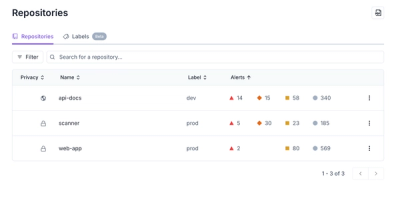
Product
Redesigned Repositories Page: A Faster Way to Prioritize Security Risk
Our redesigned Repositories page adds alert severity, filtering, and tabs for faster triage and clearer insights across all your projects.
Awkward Array is a library for nested, variable-sized data, including arbitrary-length lists, records, mixed types, and missing data, using NumPy-like idioms.
Arrays are dynamically typed, but operations on them are compiled and fast. Their behavior coincides with NumPy when array dimensions are regular and generalizes when they're not.
Given an array of objects with x, y fields and variable-length nested lists like
array = ak.Array([
[{"x": 1.1, "y": [1]}, {"x": 2.2, "y": [1, 2]}, {"x": 3.3, "y": [1, 2, 3]}],
[],
[{"x": 4.4, "y": {1, 2, 3, 4]}, {"x": 5.5, "y": [1, 2, 3, 4, 5]}]
])
the following slices out the y values, drops the first element from each inner list, and runs NumPy's np.square function on everything that is left:
output = np.square(array["y", ..., 1:])
The result is
[
[[], [4], [4, 9]],
[],
[[4, 9, 16], [4, 9, 16, 25]]
]
The equivalent using only Python is
output = []
for sublist in array:
tmp1 = []
for record in sublist:
tmp2 = []
for number in record["y"][1:]:
tmp2.append(np.square(number))
tmp1.append(tmp2)
output.append(tmp1)
Not only is the expression using Awkward Arrays more concise, using idioms familiar from NumPy, but it's much faster and uses less memory.
For a similar problem 10 million times larger than the one above (on a single-threaded 2.2 GHz processor),
Speed and memory factors in the double digits are common because we're replacing Python's dynamically typed, pointer-chasing virtual machine with type-specialized, precompiled routines on contiguous data. (In other words, for the same reasons as NumPy.) Even higher speedups are possible when Awkward Array is paired with Numba.
Our presentation at SciPy 2020 provides a good introduction, showing how to use these arrays in a real analysis.
Awkward Array can be installed from PyPI using pip:
pip install awkward
You will likely get a precompiled binary (wheel), depending on your operating system and Python version. If not, pip attempts to compile from source (which requires a C++ compiler, make, and CMake).
Awkward Array is also available using conda, which always installs a binary:
conda install -c conda-forge awkward
If you have already added conda-forge as a channel, the -c conda-forge is unnecessary. Adding the channel is recommended because it ensures that all of your packages use compatible versions:
conda config --add channels conda-forge
conda update --all

|


|
FAQs
Manipulate JSON-like data with NumPy-like idioms.
We found that awkward1 demonstrated a healthy version release cadence and project activity because the last version was released less than a year ago. It has 1 open source maintainer collaborating on the project.
Did you know?

Socket for GitHub automatically highlights issues in each pull request and monitors the health of all your open source dependencies. Discover the contents of your packages and block harmful activity before you install or update your dependencies.

Product
Our redesigned Repositories page adds alert severity, filtering, and tabs for faster triage and clearer insights across all your projects.

Security News
Slopsquatting is a new supply chain threat where AI-assisted code generators recommend hallucinated packages that attackers register and weaponize.

Security News
Multiple deserialization flaws in PyTorch Lightning could allow remote code execution when loading untrusted model files, affecting versions up to 2.4.0.